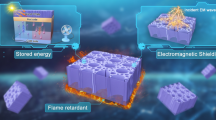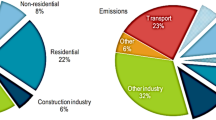Abstract
Cellulose fibers play significant roles in building passive radiative cooling (PRC) and heating (PRH), benefiting from their porous structure and low thermal conductivity. However, the fixed structure and hydrophilic groups limit the regulation of optical and thermal properties. Herein, mechanically assisted solvent extraction strategy is proposed to regenerate cellulose acetate (CA) as pea-pod-like fibers. Different from natural fibers, photonic and thermal-storage particles are introduced into CA fibers to regulate optical selectivity and thermal properties. Further considering of building surface assembly, the biomimetic fibers are compressed into rigid bio-boards to achieve buildings thermal regulation. The results demonstrate that PRC bio-board can reflect ~ 94% of solar radiation and emit ~ 96% of thermal radiation and achieve ~ 11 ℃ (Isolar > 1500 W/m2 and Tenvironment ~ 35 ℃ at daytime) and 6 ℃ (nighttime) of cooling effects. The phase-change PRH bio-board integrates solar absorption (Asolar ~ 96%), thermal insulation (Tshielding ~ 30 ℃) and storage functions, which can heat building ~ 12 ℃ under Isolar ~ 1000 W/m2 and slowly releases heat for > 1200 s. According to evaluation, the bio-units can save over 45% of energy, 1.042 $/m2 cost and 4.978 kg/(m2 year) CO2 emission in Nan**g annually. It is believed that the results have positive effects on clarifying the structure–effect relationship and promoting the commercialization of thermal management materials.







Similar content being viewed by others
Data Availability
All data are available in the main text or the supplementary materials. Requests should be directed to the corresponding authors.
References
Li T, Zhai Y, He S, Gan W, Wei Z, Heidarinejad M, et al. A radiative cooling structural material. Science. 2019;364(6442):760–3.
Sheng S-Z, Wang J-L, Zhao B, He Z, Feng X-F, Shang Q-G, et al. Nanowire-based smart windows combining electro- and thermochromics for dynamic regulation of solar radiation. Nat Commun. 2023;14(1):3231.
Song J, Zhang W, Sun Z, Pan M, Tian F, Li X, et al. Durable radiative cooling against environmental aging. Nat Commun. 2022;13(1):4805.
Feng C, Yang P, Liu H, Mao M, Liu Y, Xue T, et al. Bilayer porous polymer for efficient passive building cooling. Nano Energy. 2021;85: 105971.
Mandal J, Yang Y, Yu N, Raman AP. Paints as a scalable and effective radiative cooling technology for buildings. Joule. 2020;4(7):1350–6.
Zou H, Wang C, Yu J, Huang D, Yang R, Wang R. Solar spectrum management and radiative cooling film for sustainable greenhouse production in hot climates. Sci Bull. 2023;68(14):1493–6.
Zhu W, Zhang Y, Mohammad N, Xu W, Tunc S, Shan X, et al. Large-scale industry-compatible sub-ambient radiative cooling pulp. Cell Rep Phys Sci. 2022;3(11): 101125.
Zhu H, Wang Y, Qu M, Pan Y, Zheng G, Dai K, et al. Electrospun poly(vinyl alcohol)/silica film for radiative cooling. Adv Compos Hybrid Mater. 2022;5(3):1966–75.
Shi M, Song Z, Ni J, Du X, Cao Y, Yang Y, et al. Dual-mode porous polymeric films with coral-like hierarchical structure for all-day radiative cooling and heating. ACS Nano. 2023;17(3):2029–38.
Li X, Sheng X, Fang Y, Hu X, Gong S, Sheng M, et al. Wearable Janus-type film with integrated all-season active/passive thermal management, thermal camouflage, and ultra-high electromagnetic shielding efficiency tunable by origami process. Adv Funct Mater. 2023;33(18):2212776.
Dai B, Li X, Xu T, Zhang X. Radiative cooling and solar heating Janus films for personal thermal management. ACS Appl Mater Interfaces. 2022;14(16):18877–83.
Li S, **ao P, Yang W, Zhang C, Gu J, Kuo S-W, et al. Hierarchically nanostructured Janus membranes toward sustainable and efficient solar-to-thermal management. Adv Funct Mater. 2023;33(18):2209654.
Cai J, Du M, Li Z. Flexible temperature sensors constructed with fiber materials. Adv Mater Technol. 2022;7(7):2101182.
Zhu M, Li J, Yu J, Li Z, Ding B. Superstable and intrinsically self-healing fibrous membrane with bionic confined protective structure for breathable electronic skin. Angew Chem Int Ed. 2022;61(22): e202200226.
Zhu M, Yu J, Li Z, Ding B. Self-healing fibrous membranes. Angew Chem Int Ed. 2022;61(41): e202208949.
Liu L, Shan X, Hu X, Lv W, Wang J. Superhydrophobic silica aerogels and their layer-by-layer structure for thermal management in harsh cold and hot environments. ACS Nano. 2021;15(12):19771–82.
Hu P, Wang J, Zhang P, Wu F, Cheng Y, Wang J, et al. Hyperelastic Kevlar nanofiber aerogels as robust thermal switches for smart thermal management. Adv Mater. 2023;35(3):2207638.
Guan Q, Raza A, Mao SS, Vega LF, Zhang T. Machine learning-enabled inverse design of radiative cooling film with on-demand transmissive color. ACS Photonics. 2023;10(3):715–26.
Zhou L, Song H, Liang J, Singer M, Zhou M, Stegenburgs E, et al. A polydimethylsiloxane-coated metal structure for all-day radiative cooling. Nat Sustain. 2019;2(8):718–24.
Hossain MM, Jia B, Gu M. A metamaterial emitter for highly efficient radiative cooling. Adv Opt Mater. 2015;3(8):1047–51.
Cheng N, Miao D, Wang C, Lin Y, Babar AA, Wang X, et al. Nanosphere-structured hierarchically porous PVDF-HFP fabric for passive daytime radiative cooling via one-step water vapor-induced phase separation. Chem Eng J. 2023;460: 141581.
Zhang Y, Wang T, Mei X, Chen M, Wu L. Ordered porous polymer films for highly efficient passive daytime radiative cooling. ACS Photonics. 2023;10(9):3124–32.
Zhu W, Droguet B, Shen Q, Zhang Y, Parton TG, Shan X, et al. Structurally colored radiative cooling cellulosic films. Adv Sci. 2022;9(26):2202061.
Ma Z, Xue T, Wali Q, Miao Y-E, Fan W, Liu T. Direct ink writing of polyimide/bacterial cellulose composite aerogel for thermal insulation. Compos Commun. 2023;39: 101528.
Cai C, Wei Z, Ding C, Sun B, Chen W, Gerhard C, et al. Dynamically tunable all-weather daytime cellulose aerogel radiative supercooler for energy-saving building. Nano Lett. 2022;22(10):4106–14.
Cai S, Xu C, Jiang D, Yuan M, Zhang Q, Li Z, Wang Y. Air-permeable electrode for highly sensitive and noninvasive glucose monitoring enabled by graphene fiber fabrics. Nano Energy. 2022;93: 106904.
Li J, Cai J, Yu J, Li Z, Ding B. The rising of fiber constructed piezo/triboelectric nanogenerators: from material selections, fabrication techniques to emerging applications. Adv Funct Mater. 2023;33(44):2303249.
Lv X, Liu Y, Yu J, Li Z, Ding B. Smart fibers for self-powered electronic skins. Adv Fiber Mater. 2022;5(2):401–28.
Xu D, Ge C, Chen Z, Liu Y, Chen T, Gao C, et al. Tree-inspired braiding fibrous frameworks enabling high-efficiency and salt-rejecting solar evaporation. J Mater Chem A. 2023;11(25):13510–8.
Zhou H, Xu J, Liu X, Zhang H, Wang D, Chen Z, et al. Bio-inspired photonic materials: prototypes and structural effect designs for applications in solar energy manipulation. Adv Funct Mater. 2018;28(24):1705309.
Cheng Z, Han H, Wang F, Yan Y, Shi X, Liang H, et al. Efficient radiative cooling coating with biomimetic human skin wrinkle structure. Nano Energy. 2021;89: 106377.
Jeong SY, Tso CY, Wong YM, Chao CYH, Huang B. Daytime passive radiative cooling by ultra emissive bio-inspired polymeric surface. Sol Energy Mater Sol Cells. 2020;206: 110296.
Wang S, Wang Y, Zou Y, Chen G, Ouyang J, Jia D, et al. Biologically inspired scalable-manufactured dual-layer coating with a hierarchical micropattern for highly efficient passive radiative cooling and robust superhydrophobicity. ACS Appl Mater Interfaces. 2021;13(18):21888–97.
Cai C, Chen W, Wei Z, Ding C, Sun B, Gerhard C, et al. Bioinspired “aerogel grating” with metasurfaces for durable daytime radiative cooling for year-round energy savings. Nano Energy. 2023;114: 108625.
Choe A, Yeom J, Kwon Y, Lee Y, Shin Y-E, Kim J, et al. Stimuli-responsive micro/nanoporous hairy skin for adaptive thermal insulation and infrared camouflage. Mater Horiz. 2020;7(12):3258–65.
Yue X, He M, Zhang T, Yang D, Qiu F. Laminated fibrous membrane inspired by polar bear pelt for outdoor personal radiation management. ACS Appl Mater Interfaces. 2020;12(10):12285–93.
Acknowledgements
The work thanks for the supporting of the National Nature Science Foundation of China (52173158), National Natural Science Foundation of China (32171725) and Graduate Research and Innovation Projects of Jiangsu Province (KYCX21_0091). The authors thanks for the FDTD solutions provided by the Southeast University (China). This work is jointly completed by the corresponding author and co-authors, and no artificial intelligence (AI) participates in the process.
Author information
Authors and Affiliations
Contributions
SF conceptualization, methodology, software, investigation, formal analysis, writing-original draft; LY methodology, software, writing-original draft; MF investigation, formal analysis; HC measurements, investigation, performance evaluation; XH investigation, performance evaluation; MH conceptualization, funding acquisition, resources, supervision; XB supervision, writing-review and editing; YH supervision, writing-review and editing; YZ conceptualization, funding acquisition, resources, supervision, writing-review and editing.
Corresponding authors
Ethics declarations
Conflict of interest
The authors declare that they have no known competing financial interests or personal relationships that could have appeared to influence the work reported in this paper.
Additional information
Publisher's Note
Springer Nature remains neutral with regard to jurisdictional claims in published maps and institutional affiliations.
Supplementary Information
Below is the link to the electronic supplementary material.
Supplementary file1 (MP4 6548 KB)
42765_2024_377_MOESM2_ESM.docx
Supplementary file2 Details of materials preparation, characterization and theoretical calculation process are displayed in Supplementary Materials (DOCX 9258 KB)
Rights and permissions
Springer Nature or its licensor (e.g. a society or other partner) holds exclusive rights to this article under a publishing agreement with the author(s) or other rightsholder(s); author self-archiving of the accepted manuscript version of this article is solely governed by the terms of such publishing agreement and applicable law.
About this article
Cite this article
Feng, S., Yao, L., Feng, M. et al. Regeneration of Pea-Pod-Like Cellulose Acetate Fibers as Aerogel-Derived Boards for Building Thermal Regulation and Carbon Reduction. Adv. Fiber Mater. 6, 570–582 (2024). https://doi.org/10.1007/s42765-024-00377-w
Received:
Accepted:
Published:
Issue Date:
DOI: https://doi.org/10.1007/s42765-024-00377-w




